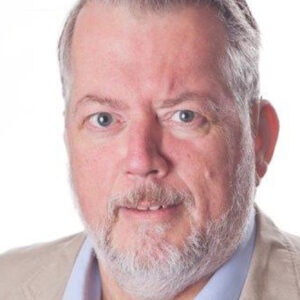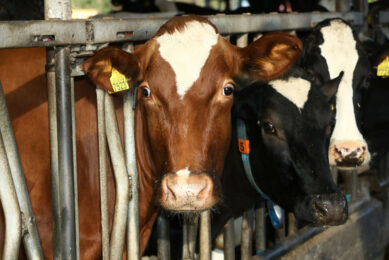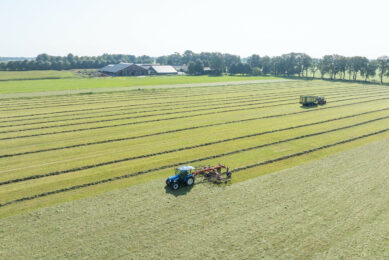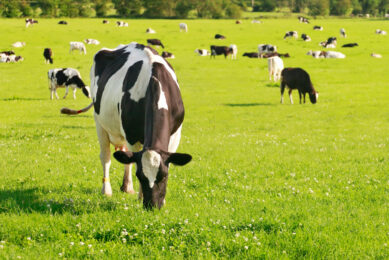Farm report, Germany: Dairy farming a different way pays off
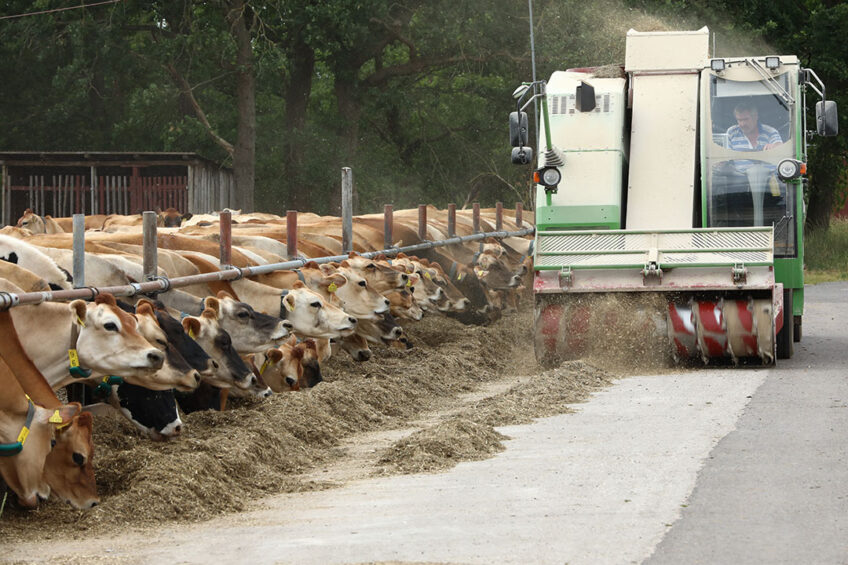
About 370 of Rainer Schmitt’s dairy cows are grazing in two groups. Only the close up group of cows are in the barn. This is remarkable, because in almost every part of Germany, and especially in the former German Democratic Republic (GDR), keeping cows inside is the norm.
PROFILE
Name: Rainer Schmitt (46) is farm manager and owns a quarter of the stocks of the Agrargenossenschaft Baruther Urstromtal in Baruth/Mark. It contains two separate farms.
Farms: The first one has 450 Jerseys with 450 hectares of grassland and feed crops. Second farm: A dairy farm 3 kilometers away was acquired in 2019, with 400 Holstein cows at 1,000 hectares (partly arable farming). The previous owners had a yield of 6,500 kilogrammes of milk. After one year, the production has reached over 10,000 kilogrammes per cow per year and is still increasing.
Milk: These Jerseys are 5 years old on average and produced 6,441 kilogrammes of milk with 5,3% fat and 4,14% protein in 2019, which was an extremely dry year. This results in 620 kilogrammes of fat and protein per year
Calving: The time between calvings is 406 days.
Strategy: A complete transition to Jerseys on the second farm is in the planning and focusing on processing all milk (in a cooperation) into cheese, which started in 2020.
“This is not Germany, this is Brandenburg,” smirks the Bavaria-born German. “We deviate from the norm, that is for sure.”
The fresh calved cows and the highly productive animals graze 10 hours per day around the home location where they are milked. The gestating cows graze at a distance of 2 kilometres at a second milking parlour. All parlours are 2×14 side-by-side barns, which were renovated in 2014. The milkers start at the home location and then move on to another location.
Moving away from mainstream methods
Not only is pasturing is a far cry from mainstream dairy methods. When driving to the farm, the bright colours immediately draw your attention. The office is painted in bright yellow and green. “I hated that boring concrete when I started here as a herd manager in 2008. When I became farm manager and main shareholder in 2014, I had it painted immediately. At least, the part that catches your eye when you drive down the road. Behind it are still many grey buildings.” Every roof is covered with solar panels. “A solar company replaces our old roofs. They installed the panels and use the roofs for free for 20 years. After that, we will be the owners.”
The barns, in typical GDR fashion, were all built for longevity in the early 70s. Several of them were modified around the year 2000, converted from stanchion to free-walk housing and cubicle barns. “In the free-walk housing, in winter we use 10 large bales of straw per day for 170 cows. In the part with the cubicles, 1,5 bales are enough for the same amount of cows.” However, he does not consider any changes. “We have enough straw from our own land. The fresh and high-productive cows are doing very well in the deep litter barn.”
Another move away from the standard way is: the breed. Only 3,500 purebred Jerseys are registered in Germany. Schmitt owns one out of every eight. “When I started here, there were 50 Jerseys, 150 Holsteins and 200 F1’s, F2’s and F3’s.
Economics are very important and at this moment at this company, Jerseys just work best. They need little feed.
Rotation crossing is certainly interesting, but I am a breeder. That means you have to work with just one breed. Economics are very important and at this moment at this company, Jerseys just work best. They need little feed. You can feed three Jerseys with the feed of two Holsteins. They produce around 7,000 litres in a normal year, with up to 6% fat and over 4% protein. Three Jerseys produce more kilogrammes of fat and protein per year than two Holsteins with 14,000 kilogrammes of milk. Our processor Müller pays an annual plus on the base price of 10 euro cents per litre on average for this fatty milk. We receive 1 cent extra for VLOG milk and another extra cent for our 3 million kilogramme quantity. When milk prices are very high, this premium is not enough compared to Holstein milk, but that only happens in 1 out of 5 years.”

Pasture
There are several reasons for pasturing. One is cost reduction. “Cows are the best mowers and loaders ever,” and just as important: the soil type. The 450 hectare plot consists of 230 hectares of peat soil, which is not suitable for anything else than grass cultivation. The other 220 hectares consist of poor and drought sensitive sandy soil. This is only suitable for arable farming, so the farm cultivates 90 hectares of silage maize, 50 hectares of rye, 50 hectares of barley and 30 hectares of alfalfa. Not for sale though; everything is added to the cows’ and youngstock’s rations. “The only things we buy are some rapeseed and minerals.”
The crop yields are very volatile. The soil has only 18 soil points. There is little soil to be found anywhere in Germany that is worse than this. As a result, the lease rate is about €150 per hectare. It sells for €8,000 per hectare.
Because of the varying yields, it is sometimes necessary to buy feed. “At the end of 2017, we had sizeable supplies, which we all fed in 2018. In the even drier 2019, we bought 1,000 tons of maize and 1,000 tons of grass silage, with €60.000 worth of financial damages as a result. This year, the grass harvest is excellent. If the maize gets some rain in the coming weeks, we can start building supplies again, Otherwise, we have to buy extra, but less than in 2019.”

The farm has hardly been financed with borrowed capital. Half the land is owned, the other half is leased. “We have acquired over 10 hectares last year. We could have done that with our current account, but because of the low interest rates of just over 1%, we decided to have it financed to keep room for investment.” The operation’s net result varies from -€50.000 to +€250.000 per year.
Cheese
The farmer started developing a new branch in the business in 2018: cheese. “We are located at about 50 kilometres from the Potzdamer Platz in the center of Berlin, a city with 3,5 million ‘very green’ inhabitants. We produce around 3,5 million kilogrammes of milk with a story. Local production, cows that pasture day and night at photogenic locations, we have a reception area with room for a 100 people that also functions as a classroom and we have GMO free A2A2 milk. So it’s a logical step, right?”

So Schmitt invested €100,000 in equipment and hired an employee for the cheese production and marketing. “I do not have time to be at every market.” It eventually became a costly adventure. “Only you decide where you want to burn your money. The lady I hired turned out to be less capable than I thought.”
That is why he recently changed course, by establishing a private company (Ltd.) together with a Belgian-English couple. They have ample experience in cheese production and direct sales to individuals in Berlin. “They know the product and what sells and they are good at it. They were looking for a supplier with a story and the necessary volume. A match made in heaven. We have the facilities and a story to tell, they know cheese and the market.”
The couple owns 40% of the company, Baruther Urstromtal owns 20%. “They have to use our milk and pay a few cents on top of what Müller pays for it. It will really take off in September. This year, they plan on purchasing at least 200,000 kilogrammes of milk.”
Schmitt does not say much about the future. However, the smile on his face after joking about ‘marketing all milk as cheese in 2025’ says it all.

Acquisition
A contributing factor in the cheese debacle of 2019 was that the farm suddenly needed more attention. A neighbouring farm went bankrupt and there was a lot of pressure to acquire it, against favourable conditions. The farm, with 400 Holstein cows on 1,000 hectares, half of which was commercial arable farming, was in demand and the neighbourhood feared the arrival of rich Bavarian or Dutch dairy farmers. “That would disrupt the balance in this region and increase lease prices.”
Around the time of the acquisition, the Holsteins produced just below 6,500 kilogrammes per cow annually. “Holsteins should easily be able to produce at least 8,000 kilogrammes.” A year after the acquisition, the daily production of the Holsteins increased to just over 10,000 kilogrammes per cow per year.
Despite the excellent production, Schmitt wants to have Jerseys only at this location in 4 years’ time. To reach that goal, he buys heifers, but not from his own farm. “Baruther Urstromtal structurally sells over 150 heifers per year, at about €1,600 each. We can buy them for €1,200 elsewhere. That saves us €60,000 per year.”
Schmitt does not only produce heifers. “We have about 200 young bulls each year. Several dozens of them leave the farm as breeding bulls. We sell some 150 bulls per year to small individual land owners that fatten them. They don’t yield much in euros, but we do not have to have them slaughtered after birth. That only happens to around 20 young bulls per year.”
Now that he has more land, he is considering fattening the bulls himself.
Improving Holstein production took a lot of time and even more guidance was needed for the employees. “The atmosphere between them was tense during and after the acquisition. I did not lay anyone off, but of the 15 employees with whom we initially started, none are left now. They probably could not handle the new way of working.”

It may seem that Schmitt has too much of a dominant character, but the opposite is true. During a round on the farm, one of the calf minders stops him to ask for advice. The ensuing conversation is open, friendly and leads to a joint conclusion. “Thank you for asking me about this,” Schmitt says afterwards. The employee will certainly not hesitate to ask again. “I want people who can solve problems, but are not afraid to share their struggles either. Everyone makes mistakes, that’s no problem. Just do not hesitate to mention them. I would rather see an employee who doubts whether or not he milked a penicillin cow and tells me so, I would rather have that, than one who chooses to remain silent, hopes for the best and I am left with an enormous bill. I won’t stay friendly for long in that case.”
Join 13,000+ subscribers
Subscribe to our newsletter to stay updated about all the need-to-know content in the dairy sector, two times a week.


